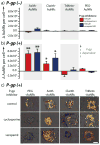P-glycoprotein-dependent trafficking of nanoparticle-drug conjugates
- PMID: 24616407
- PMCID: PMC4136971
- DOI: 10.1002/smll.201303190
P-glycoprotein-dependent trafficking of nanoparticle-drug conjugates
Keywords: colloids; gold; nanoparticles; nanorods; nanotechnology.
Figures



References
-
- Goldman B. J Natl Cancer Inst. 2003;95:255. - PubMed
-
- Zavaleta CL, Smith BR, Walton I, Doering W, Davis G, Shojaei B, Natan MJ, Gambhir SS. Proc Natl Acad Sci USA. 2009;106:13511. - PMC - PubMed
- Zavaleta C, Garai E, Liu J, Sensarn S, Mandella M, Van de Sompel D, Friedland S, Van Dam J, Contag C, Gambhir S. Proc Natl Acad Sci U S A. 2013;110:97. - PMC - PubMed
- Cheng Y, Samia AC, Meyers JD, Panagopoulos I, Fei B, Burda C. J Am Chem Soc. 2008;130:10643. - PMC - PubMed
- Cheng Y, Meyers JD, Broome AM, Kenney ME, Basilion JP, Burda C. J Am Chem Soc. 2011;133:2583. - PMC - PubMed
- Hauck TS, Ghazani AA, Chan WCW. Small. 2008;4:153. - PubMed
- Kim BYS, Rutka JT, Chan WCW. New Engl J Med. 2010;363:2434. - PubMed
- Lohse S, Murphy C. J Am Chem Soc. 2012;134:15607. - PubMed
- Murphy CJ, Gole AM, Stone JW, Sisco PN, Alkilany AM, Goldsmith EC, Baxter SC. Acc Chem Res. 2008;41:1721. - PubMed
- Dreaden EC, Alkilany AM, Huang X, Murphy CJ, El-Sayed MA. Chem Soc Rev. 2012;41:2740. - PMC - PubMed
Publication types
MeSH terms
Substances
Grants and funding
LinkOut - more resources
Full Text Sources
Other Literature Sources
Medical

